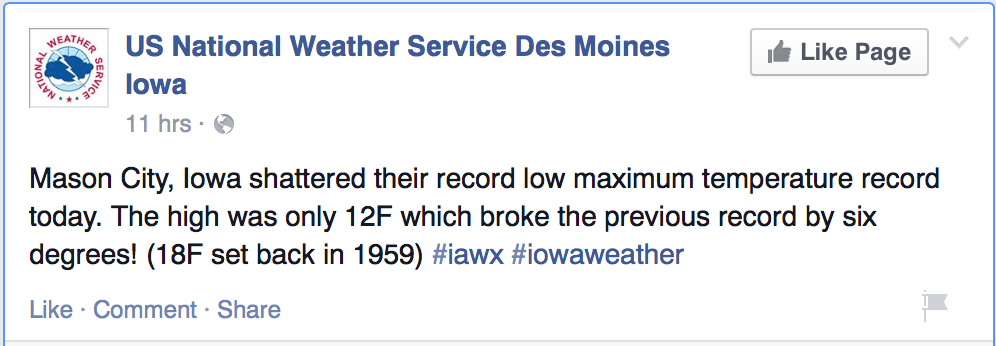As I did chores yesterday morning, it felt like we were in the middle of January instead of the middle of November! Twenty-mile-an-hour winds whipped snow around the corner of the buildings. I had to make sure the curtains were working to regulate the temperatures inside my hog barns, so I was sweating when I was inside the barn and freezing on the outside. Even as cold as it was outside, 300-pound pigs create a lot of heat inside my barns. That means the curtains must go up and down to keep it comfy for the pigs! The pigs definitely had it better than I as they stayed inside, warm and dry, with the ability to eat and drink whenever they get the urge.
When I saw this weather report, I realized why I felt so miserable:
I don’t even want to know what the wind chill was!
After battling frigid temperatures all morning, I went inside to my office to sort through some of the papers on my desk. I’ve been reading where the billions of dollars go in our Farm Bill. Funding for Supplemental Nutrition Assistance Program (SNAP) accounts for 80% of the Farm Bill, so it would appear U.S. farmers get to fight over the remaining 20%.
SNAP has been a part of the Farm Bill for years, but it’s become an increasingly large budget item. SNAP cost almost $80 billion last year – twice the amount it cost just five years ago! Page 2 of the FY2015 USDA Budget Summary shows that U.S. Farm and Commodity programs only receive 11% of Farm Bill funding, so my curiosity led me to explore where some of this money goes.
It appears that a significant amount of USDA (U.S. Department of Agriculture) funds don’t even support U.S. farmers and ranchers. An article posted Nov. 4 by Joani Dong, Foreign Service Agriculture Attaché, provides an update on The Food for Progress Program. Administered by USDA’s Foreign Agricultural Service, this program helps developing countries like Senegal modernize and strengthen their agricultural sectors using proceeds from U.S. agricultural commodities.
In essence, Food for Progress uses commodities we donate to that country and sells them. For example, a ribbon cutting ceremony was recently held for a 7.5-mile road in Senegal that will help local farmers get products to market. This road links agriculture production zones to the major highway, which is being built with funding from the Millennium Challenge Corporation. Another 10 miles of roads should be completed by year’s end, and a 3-year plans includes the development of 73.3 miles of feeder roads.
Another example of how the USDA’s Food for Progress Program is helping individual farmers expand takes us to Ethiopia. Michael Francom, Agriculture Counselor, U.S. Embassy, Addis Ababa, posted on Sept. 4 how U.S.-donated commodities have helped a small dairy farmer, Ms. Yetemwork Tilahun, expand her farm.
“[Funding] has allowed her to expand her operation from a single dairy cow to her current herd of 10 crossbred Holsteins, each valued at about $3,000 (USD),” writes Francom. “As a result of this expansion, Ms. Yetemwork is not only able to provide her family with fresh milk, but is also able to generate extra income by selling surplus production to several restaurants and hotels, as well as the nearby cooperative.”
These are all good programs, right? Honestly, I’m the type of person that seems to always worry about the whole world. I’m truly concerned for the under fed and the under employed. I would love for the world to be… happy. Yet, the U.S. can’t afford to literally run huge deficits in an attempt to save the whole world.
Let’s focus on helping our own country’s agricultural sector to grow and thrive! I prefer my food grown here, not imported. Unnecessary regulations, cumbersome paperwork and tax burdens drive business out of our country.

